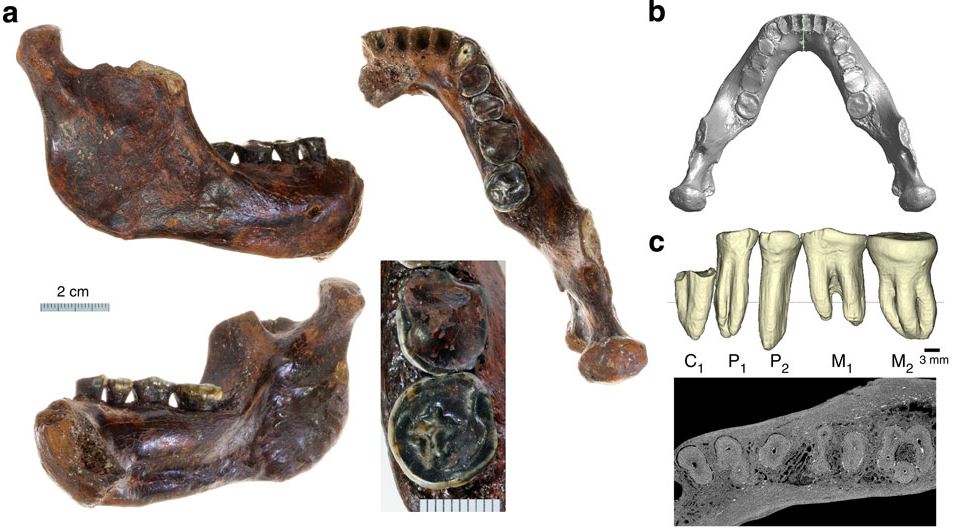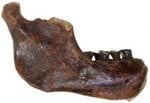A four-inch long fossilized jawbone of an ancient human with particularly large teeth from between 130,000 and 190,000 years ago was dredged up by fishermen working off the Taiwanese coast, an article in Nature Communications (citation below) reports.
The short-thick mandible (jawbone) shows that this previously unknown ancient human had a much stronger jaw than our other ancestors who lived in the area.
South Korean, Japanese and Australian scientists say the find helps fill a geographical gap in the Asian fossil record, and also shows the diversity of early humans living in the region in the Pleistocene era.

(a) Mandible, (b) its virtual reconstruction and (c) surface rendered image of the segmented mandibular dentition (upper, lingual view) and its horizontal micro-CT section at the level indicated by the dotted line (lower). (Image: Nature Communications)
A wide range of ancient *hominins existed in Eastern Asia during the Pleistocene, including the long-lived and successful Homo erectus found in China and Java, the smaller Homo floresiensis (the so-called ‘hobbit’ hominid) from the Indonesian island of Flores, and the Denisovans and Neanderthals of the Russian Altai mountains.
* Hominins refers to modern humans, extinct human species and all our immediate ancestors.
It was not possible to determine the sex, age or size of the body of the hominin.
Team leader, Chun-Hsiang Chang, from the National Museum of Natural Science in Taiwan, Yousuke Kaifu, from the University of Tokyo, and colleagues report that the fossil, dredged up from the Penghu submarine channel off the western coast of Taiwan, is a “robust mandible with primitive-looking teeth.”
The jawbone has a similar structure to that of a Middle Pleistocene Homo discovered in Hexian, a district of Anhui Province in the People’s Republic of China. The new Taiwanese hominin has been dubbed Penghu 1.
It was not possible to determine the age of the remains using radiocarbon, but a comparative analysis of fluorine and sodium in the fossil, plus other animal bones recovered from the same area, suggest Penghu 1 was around between 130,000 and 190,000 years ago.
Taiwan Today quoted Mr. Chang, who said:
“Exhibiting distinctly primitive dentognathic traits, Homo erectus did not need to evolve significantly for survival as it led a comfortable life in the relatively safe surrounds provided by Taiwan.”
The two findings suggest there were several evolutionary lineages of ancient hominins existing in eastern Asia during the Pleistocene, before modern humans emerged in the region about 40,000 years ago.
Citation: “The first archaic Homo from Taiwan,” Chun-Hsiang Chang, Yousuke Kaifu, Masanaru Takai, Reiko T. Kono, Rainer Grün, Shuji Matsu’ura, Les Kinsley & Liang-Kong Lin. Nature Communications 6, Article number: 6037. doi:10.1038/ncomms7037.

